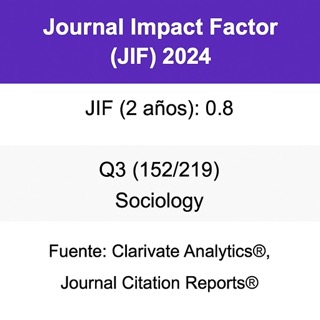Desigualdad persistente, pero no un techo de cristal. Sobre género y autoridad en el trabajo
DOI:
https://doi.org/10.22325/fes/res.2021.43Palabras clave:
Autoridad en el trabajo, brecha de género, techo de cristal, desigualdad de género, Erik WrightResumen
El objetivo del artículo es estudiar las desigualdades de género en autoridad en el trabajo en España, tomando como punto de partida las aportaciones de Erik Wright. Se describe la magnitud, forma y variación temporal de esta desigualdad y se pone a prueba la hipótesis del "techo de cristal", es decir, la hipótesis de que la desventaja relativa de las mujeres es mayor en los niveles más altos de la jerarquía de autoridad que en los inferiores. Los datos proceden de la "Encuesta de Estructura, Conciencia y Biografía de Clase" (1991), la "Encuesta Sociodemográfica" del INE (1991), la "Encuesta de Calidad de Vida en el Trabajo" (1999-2004) y varias submuestras anuales de la "Encuesta de Población Activa" (2006-2013). Se concluye que, en España, hombres y mujeres tienen probabilidades desiguales de ocupar posiciones de autoridad, pero la evidencia disponible no respalda la hipótesis del "techo de cristal".
Citas
Abendroth, A. K., Maas, I. y Van der Lippe, T. (2013). Human capital and the gender gap in authority in European countries. European Sociological Review, 29(2), 261-273. https://doi.org/10.1093/esr/jcr059
Albrecht, J., Björklund, A. y Vroman, S. (2003). Is there a glass ceiling in Sweden? Journal of Labor Economics, 21(1), 145-177. http://dx.doi.org/10.1086/344126
Albrecht, J., Skogman Thoursie, P. y Vroman, S. (2015). Parental leave and the glass ceiling in Sweden. En S. W. Polachek, K. Tatsiramos y K. F. Zimmermann, Gender convergence in the labor market (pp. 89-114). Bingley: Emerald. https://doi.org/10.1108/S0147-912120140000041010
Allison, P. D. (1999). Comparing logit and probit coefficients across groups. Sociological Methods and Research, 28(2), 186-208. https://doi.org/10.1177/0049124199028002003
Baxter, J. y Wright, E. O. (2000). The glass ceiling hypothesis: A comparative study of the United States, Sweden, and Australia. Gender and Society, 14(2), 275-294. https://doi.org/10.1177/089124300014002004
Bihagen, E. y Ohls, M. (2006). The glass ceiling –where is it? Women’s and men’s career prospects in the private vs. the public sector in Sweden 1979-2000. Sociological Review, 54(1), 20-47. https://doi.org/10.1111/j.1467-954X.2006.00600.x
Birkelund, G. y Sandnes, T. (2003). Paradoxes of welfare states and equal opportunities: Gender and managerial power in Norway and the USA. Comparative Social Research, 21, 203-242.
Booth, A. L., Francesconi, M. y Frank, J. (2003). A sticky floors model of promotion, pay, and gender. European Economic Review, 47, 295-322. https://doi.org/10.1016/S0014-2921(01)00197-0
Britton, D. M. y Williams, C. L. (2000). Response to Baxter and Wright. Gender and Society, 14(6), 804-808.
Buis, M. L. (2017). Logistic regression: When can we do what we think we can do? Recuperado de http://www.maartenbuis.nl/wp/odds_ratio_3.1.pdf
Bygren, M. y Gähler, M. (2007). The gender gap in workplace authority in Sweden, 1968-2000: A family affair? Uppsala: Institute for Labour Market Policy Evaluation, Working Paper, 2007/28.
Carabaña, J., González, J. J., Serrano, A., Vallejos, A., Veredas, S. y Rivière, J. (1992). Encuesta de estructura, conciencia y biografía de clase. Descripción detallada del proyecto, definiciones, depuración de la información y ficheros de datos. Madrid: Comunidad de Madrid.
Cotter, D. A., Hermsen, J. M., Ovadia, S. y Vanneman, R. (2001). The glass ceiling effect. Social Forces, 80(2), 655-682. https://doi.org/10.1353/sof.2001.0091
Crompton, R. (2006). Employment and the family: The reconfiguration of work and family life in contemporary societies. Cambridge: Cambridge University Press.
Elliott, J. R. y Smith, R. A. (2004). Race, gender, and workplace power. American Sociological Review, 69(3), 365-386. https://doi.org/10.1177/000312240406900303
Eswaran, M. (2014). Why gender matters in economics. Princeton: Princeton University Press.
Ferree, M. y Purkayastha, B. (2000). Equality and cumulative disadvantage: Response to Baxter and Wright. Gender and Society, 14(6), 809-813. https://doi.org/10.1177/089124300014006007
Fleiss, J. L., Levin, B, y Paik, M. C. (2003). Statistical methods for rates and proportions. Hoboken, NJ: Wiley.
Garrido, L. y Miyar, M (2008). Dinámica laboral de la inmigración en España durante el principio del siglo XXI. Panorama Social, (8), 52-70.
Gorman, E. H. y Kmec, J. (2009). Hierarchical rank and women’s organizational mobility: Glass ceilings in corporate law firms. American Journal of Sociology, 114(5), 1428-1474. https://doi.org/10.1086/595950
Hakim, C. (2000). Work-lifestyle choices in the 21st century. Oxford: Oxford University Press.
Hakim, C. (2004). Key issues in women’s work (2.a ed.). Londres: Glasshouse Press.
Helgertz, J. (2011). Thou shalt not pass? Examining the existence of an immigrant glass ceiling in Sweden, 1970-1990. Demographic Research, 24(1), 1-44.
Henrekson, M. y Stenkula, M. (2009). Why are there so few female top executives in egalitarian welfare states? IFN Working Paper, 786.
Hultin, M. (2001). Consider her adversity: Four essays on gender inequality in the labor market. Estocolmo: Swedish Institute for Social Research.
Instituto Nacional de Estadística (1993). Encuesta sociodemográfica. Metodología y resultados. Madrid: INE.
Iversen, T., Rosenbluth, F. M. y Skorge, O. (2020). The dilema of gender equality: How labor market regulation divides women by class. Daedalus, 149(1), 86-99. https://doi.org/10.1162/DAED_a_01775
Jackson, J. F. L. y O’Callaghan, E. M. (2007). The glass ceiling: A misunderstood form of discrimination. Milwaukee: Institute on Race and Ethnicity/University of Wisconsin System
Korpi, W., Ferrarini, T. y Englund, S. (2013). Women’s opportunities under different family policy constellations: Gender, class, and inequality tradeoffs in Western countries re-examined. Social Politics, 20(1), 1-40. https://doi.org/10.1093/sp/jxs028
Kuha, J. y Mills, C. (2018). On group comparisons with logistic regression models. Sociological Methods and Research, 49(2), 498-525. https://doi.org/10.1177/0049124117747306
Lazear, E. P. y Rosen, S. (1990). Male-female wage differentials in job ladders. Journal of Labor Economics, 8(1), 106-123.
Mandel, H. (2009). Configurations of gender inequality: The consequences of ideology and public policy. British Journal of Sociology, 60(4), 694-719. https://doi.org/10.1111/j.1468-4446.2009.01271.x
Mandel, H. (2011). Rethinking the paradox: Tradeoffs in work-family policy and patterns of gender inequality. Community, Work and Family, 14(2), 159-176. https://doi.org/10.1080/13668803.2011.571397
Mandel, H. y Semyonov, M. (2006). A welfare state paradox: State interventions and women’s employment opportunities in 22 countries. American Journal of Sociology, 111(6), 1910-1949. https://doi.org/10.1086/499912
Maume, D. J. (2004). Is the glass ceiling a unique form of inequality? Evidence from a random-effects model of managerial attainment. Work and Occupations, 31(2), 250-274. https://doi.org/10.1177/0730888404263908
Mood, C. (2010). Logistic regression: Why we cannot do what we think we can do, and what we can do about it. European Sociological Review, 26(1), 67-82. https://doi.org/10.1093/esr/jcp006
Norton, E. C. (2012). Log odds and ends. NBER Working Paper Series, 18252. Recuperado de http://www.nber.org/papers/w18252
Powell, G. N. y Butterfield, D. A. (1994). Investigating the ‘glass ceiling’ phenomenon: An empirical study of actual promotions to top management. Academy of Management Journal, 37(1), 68-86.
Purcell, D., MacArthur, K. R. y Samblanet, S. (2010). Gender and the glass ceiling at work. Sociology Compass, 4(9), 705-727. https://doi.org/10.1111/j.1751-9020.2010.00304.x
Ramos, M. (2016). Competencies, firms and qualification mismatch: Returns to education and its limits (Tesis doctoral). Universidad de Alcalá, Departamento de Economía, Alcalá de Henares.
Rosenfeld, R. A., Van Buren, M. E. y Kalleberg, A. L. (1998). Gender differences in supervisory authority: Variation among advanced industrialized democracies. Social Science Research, 27(1), 23-49. https://doi.org/10.1006/ssre.1997.0609
Sousa-Poza, A. y Ziegler, A. (2003). Asymmetric information about workers’ productivity as a cause for inefficient long working hours. Labour Economics, 10(6), 727-747. https://doi.org/10.1016/S0927-5371(03)00016-2
Spence, M. (1973). Job market signalling. The Quarterly Journal of Economics, 87(3), 355-374. https://doi.org/10.2307/1882010
Williams, R. (2009). Using heterogeneous choice models to compare logit and probit coefficients across groups. Sociological Methods and Research, 37(4), 531-559. https://doi.org/10.1177/0049124109335735
Wright, E. O. (1997). Class counts: Comparative analysis in class analysis. Cambridge: Cambridge University Press.
Wright, E. O. y Baxter, J. (2000). The glass ceiling hypothesis: A reply to critics. Gender and Society, 14(6), 814-821. https://doi.org/10.1177/089124300014006008
Wright, E. O., Baxter, J. y Birkelund, G. E. (1995). The gender gap in workplace authority: A cross-national study. American Sociological Review, 60(3), 407-435. https://doi.org/10.2307/2096422
Yaish, M. y Stier, H. (2009). Gender inequality in job authority: A cross-national comparison of 26 countries. Work and Occupations, 36(4), 343-366. https://doi.org/10.1177/0730888409349751
Yamagata, H., Yeh, K. S., Stewman, S. y Dodge, H. (1997). Sex segregation and glass ceilings: A comparative statics model of women’s career opportunities in the Federal government over a quarter century. American Journal of Sociology, 103(3), 566-632.
Zeng, Z. (2011). The myth of the glass ceiling: Evidence from a stock-flow analysis of authority attainment. Social Science Research, 40(1), 312-325. https://doi.org/10.1016/j.ssresearch.2010.06.012
Publicado
Cómo citar
Número
Sección
Licencia
Derechos de autor 2021 Revista Española de Sociología

Esta obra está bajo una licencia internacional Creative Commons Atribución-NoComercial 4.0.
Todas las publicaciones de la Revista Española de Sociología se realizarán bajo una licencia abierta Creative Commons de Reconocimiento 4.0 Internacional (CC BY 4.0). Dicha licencia establece que los autores son los poseedores de los derechos de propiedad intelectual de sus trabajos, que pueden redistribuirse a cambio de un reconocimiento adecuado. Para más información de la licencia Creative Commons, consultar aquí.
Una vez aceptado un artículo para su publicación, la Revista Española de Sociología solicitará al denominado "autor para la correspondencia" la aceptación de una licencia obligatoria Creative Commons incluida en un acuerdo o contrato de publicación.



